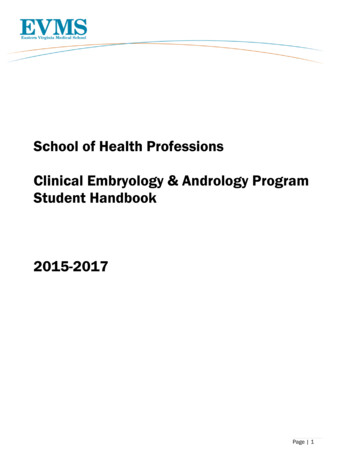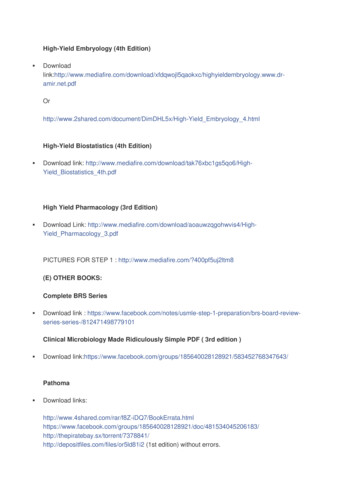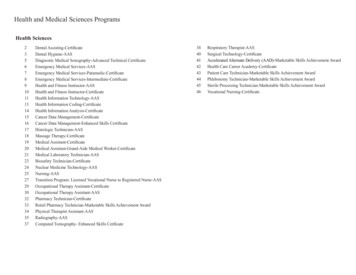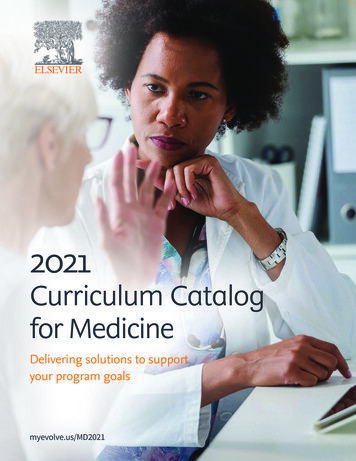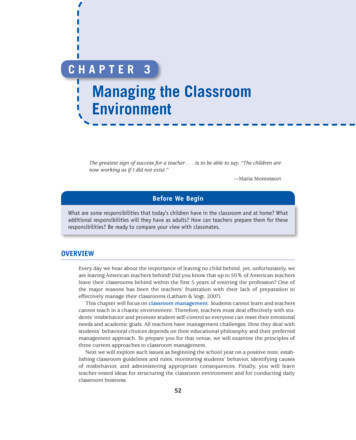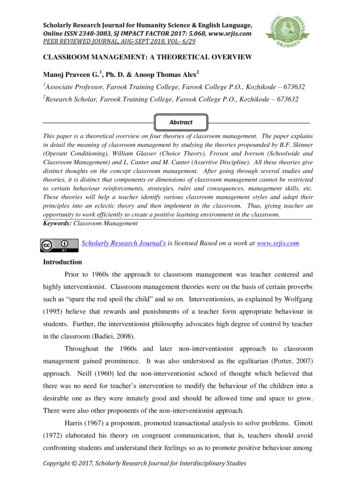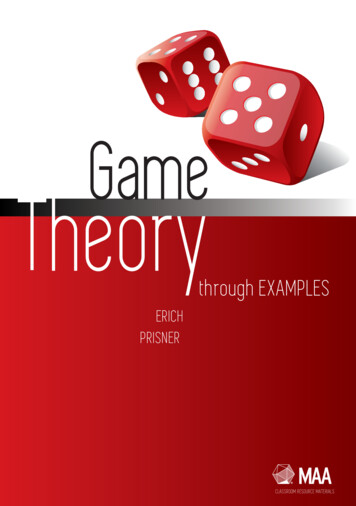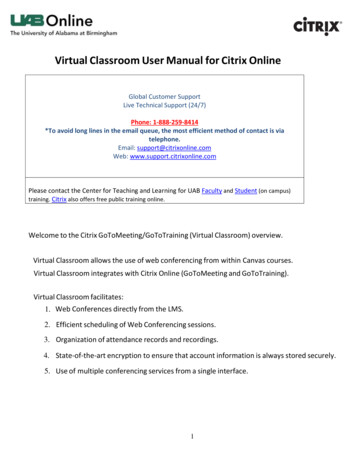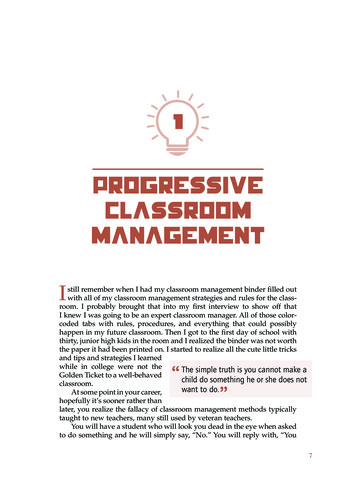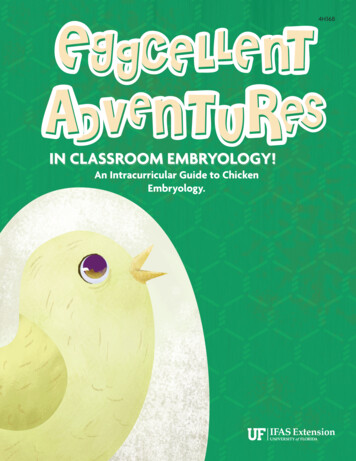
Transcription
EGGCELLENT ADVENTURES4H368IN CLASSROOM EMBRYOLOGY!An Intracurricular Guide to ChickenEmbryology.1
EGGCELLENT ADVENTURES4-H EXPERIENTIAL LEARNING MODELCurrent research points to the advantage of authentic instruction that involves “active knowledgeconstruction” by learners, relevance, active feedback on learner progress, ongoing opportunities to rethink and reflect, and highly interactive learning activities (Eccles & Gootman, 2002). For decades, 4-H YouthDevelopment has been using active knowledge construction processes through a process called experientiallearning.WHY USE EXPERIENTIAL LEARNING? Multiple senses can increase retention. Multiple teaching methods can be integrated to maximize creativity. Child-centered learning becomes the focus. Discovery of knowledge and solutions builds competence and confidence. Students can learn life skills that will be used, in addition to subject matter content. Learning is more fun!4-H Youth Development relies heavily upon the five steps of the experiential learning model to teach lifeskills (Figure 1). The sequential steps of the model help students identify what they have learned from a 4-Hexperience or activity and to apply that learning to other experiences or situations.This model requires that the “teacher/leader” be very clear about the skill or concept targeted and that theexperience and the processing questions are designed to support that learner goal. The experiential learningprocess engages the learners in all phases of the activity, resulting in the ability to generalize this learning tonew situations.3
EGGCELLENT ADVENTURESTABLE OF CONTENTSEmbryology 101. 6Eggceptional Products.49Chick Journal. 7Baby Chick. 52Basics of Embryology. 9Eggcellent Vocabulary. 54Schedule During Incubation. 10Cooking With Eggs. 56Planning And Scheduling Checklists Teacher.11All About Eggs Word Search. 62Planning And Scheduling Checklists Student.12Eggciting Criss-Cross Puzzle. 63What Is Embryology?.13Make-A-Word.66Parts of The Egg.15Fact Or Opinion.69Chick Development. 18Pecking Order. 72Chick Growth. 20Eggs-Traordinary Fractions. 74“21 Days” Song. 23Eggciting Writing. 77Egg Production. 24Eggcellent Vocabulary. 78Candled Egg. 26Create An Egg. 79Pick-A-Chick. 27Don’t Count Your Chickens Before They Hatch.80Chicken Breeds Part 1. 28Vocabulary.84Chicken Breeds Part 2. 30References.86The Little Red Hen. 33The Magic Egg. 36The Magic Egg Worksheet. 37Eggciting Fractions. 38What Is The Temperature?.41What Happened?. 43Egg Word Search.465
EGGCELLENT ADVENTURESEMBRYOLOGY 101WHAT IS CHICKEN EMBRYOLOGY, ANDHOW CAN I INCORPORATE IT INTO MYCLASSROOM?Embryology is the study of how embryos grow anddevelop. What kinds of things grow and develop fromembryos? All plants and animals develop from embryos.Just as a lima bean is the embryo of a lima bean plant, afertilized chicken egg is an embryo of a chicken.Eggcellent Adventures in Classroom Embryology is aboutlearning through experience. Students see firsthandhow a chicken develops in an egg through a seriesof activities. Students can observe the growth fromcandling sessions that show the development of thechick; the students can record data, make predictions,and conclude what they think the final outcome will be.In most cases, when a teacher signs up to teachchicken embryology in the classroom, they set up theincubator, set the eggs, and wait for them to hatch—that is the experience. This guide, however, has lessonsto incorporate into a daily plan in order to make thechicken embryology experience an intracurricularexperience. The lessons follow Florida Sunshine StateStandards and incorporate activities from varioussources. Each lesson contains an experience, instructionson how to do the experience, background informationif needed, and reflection questions. There are a totalof 31 lessons for the unit, or approximately two lessonsfor each day of in-class instruction. Overall, the lessonsaddress agricultural literacy and science concepts, butthey also address math, language arts, and visual arts.HOW LONG IS THIS UNIT? WHAT DOES ITREQUIRE OF ME AS A TEACHER?From start to finish, it takes chicks approximately 21 daysto hatch. Typically, a unit on chicken embryology is aminimum of 15 instructional days. The lessons will onlyinclude the days that students are in the classroom. Theunit can also be made longer as desired.As the teacher, this project comes with a great amountof responsibility, but don’t let that scare you away! This6is a very rewarding experience for both the instructorand students involved. This unit requires taking care ofchicken eggs, an incubator, and eventually baby chickens.The eggs and incubator require frequent monitoring,and once the chicks hatch they require special care aswell. In addition, when the experience is over, teachersare responsible for cleaning equipment and returningeverything just as it was given to them.
EGGCELLENT ADVENTURESCHICK JOURNALUSING A CHICK JOURNALA chick journal is a great way for students to documentand record what they learn over the period of theproject. A chick journal can be as simple as a pocketfolder with fasteners to hold worksheets/sheets ofnotebook paper from activities. It can also be as fancy asa printed-up workbook with the lessons included. Thisis all flexible based on the needs and resources of theclass.4. Post-Letter — This letter goes home to families totell them that the embryology experience may beover, but there is more in 4-H that is available!5. Evaluation — This evaluation is tool geared todemonstrate the outcomes and impacts that theembryology program has in the classroom. Withoutan evaluation, how can we prove that the program isgood?It is encouraged that the students are incorporatingwhat they are learning in the varying subject areasthroughout the project for retention. In addition, thechick journal is a great way for students to show theirparents what they are doing in class. Having studentsuse the journals is a great way to focus their enthusiasmabout the project. For example, students constantlywant to check the incubator and eggs. Having themdocument the results daily will not only help you as theteacher to remember data, but, if the students havea task they are to complete, they may be less likely tointerrupt other classmates and/or the teacher about theincubator.ADDITIONAL RESOURCES AVAILABLE FORTHE CLASSROOM EXPERIENCEThe following resources are available resenters.shtml1. Classroom Poster — This poster is a great way tolet the school know that you are participating inthe embryology project. Post it on your door to leteveryone know!2. Postcard — This postcard is to be sent home withstudents to let their families know what the studentsare doing in the classroom.3. Safe Handling Poster — This poster is a guide tohelp students and teachers remember the safehandling procedures when it comes to eggs andchickens.7
EGGCELLENT ADVENTURESSAMPLE SCHEDULE FOR EMBRYOLOGY LESSONSDAY123456789101112131415LESSONINTRODUCTION TO EMBRYOLOGY*WHAT IS EMBRYOLOGYPARTS OF EGG**CHICK DEVELOPMENT**CHICK GROWTH**21 DAYS SONG**EGG PRODUCTION*CANDLED EGG**PICK-A-CHICK**CHICKEN BREEDS**THE LITTLE RED HEN**THE MAGIC EGG**EGGCITING FRACTIONSWHAT IS TEMPERATURE?**WHAT HAPPENED?EGG WORD SEARCH**EGGCEPTIONAL PRODUCTSBABY CHICK**EGGCELLENT VOCABULARY**PECKING PROTEINEGGCITING CRISS-CROSS PUZZLE**MAKE-A-WORD**FACT OR OPINION**PECKING ORDEREGGSTRAORDINARY FRACTIONSEGGCITING WRITINGEGGCELLENT VOCABULARY II**CREATE AN EGG**DON’T COUNT YOUR CHICKENS BEFORE THEY HATCHEVALUATION*** SUBMIT TO AGENTWHOTEACHESTIME45 MIN–1 HRAGENT1 HOURTEACHER20 MINTEACHER1 HOURTEACHER1–1.5 HRAGENTTEACHER45 MINTEACHER1 HOURTEACHER25 MIN–1 HRTEACHER45 MIN–1 HRTEACHER30–45 MINTEACHER30 MIN–1 HRTEACHER30–45 MINTEACHER1–1.5 HRTEACHER1 HOURTEACHER1.5 HOURTEACHER*Indicate lessons that ensure basic information for embryology. ** Indicates lessons that go with chick journal.8
EGGCELLENT ADVENTURESBASICS OF EMBRYOLOGYBASIC INFORMATION ON CHICKENEMBRYOLOGYit is not strong enough to get out of the shell, it is notstrong enough to survive!It takes 21 days for chicks to hatch.It is imperative that chicks stay in the incubator untilthey are completely dry and fluffy.Hatching rates all depend on the factors of temperature,humidity, egg position and air exchange being preciseand maintained. Temperature: The temperature for a forced-airincubator is 99.5 F, and the temperature is 101 Fto 103 F for a still-air incubator with the bulb ofthe thermometer at the TOP of the eggs. Be sure that the incubator is not in directsunlight or drafts or subject to otherconditions that may alter the temperature.The best room temperature for incubators isbetween 75 F and 80 F. Humidity: Humidity helps the eggs from dryingout. Relative humidity should be 60% for thefirst 18 days and then increased to 65%–70%. Thisis important so the chicks can hatch.Do not let students handle baby chicks. Handlingincreases the risk for their survival in the first few days.Depending on the embryology program, theincubators, egg turners, brooder boxes, andother supplies may be provided. In manycases, only incubators are provided to theclassrooms. If you plan on participating inthe program frequently, it is suggested thatyou invest in your own supplies to ensurethat all the equipment is always functioningat its best. Egg position: The more pointed end of the eggshould point down (the air cell should be at thetop). Eggs must be turned routinely throughout theday so that the developing embryo does notstick to the shell. Turning the eggs in differentdirections prevents twisting of the embryonicmembranes. An odd number of turning timesprevents the eggs from being in the sameposition each night. This can also be easier ifan egg turner is used (an egg turner should beremoved on the 18th day). Air exchange: Make sure that all hands arewashed before handling the eggs. Oils fromhuman skin can reduce air exchange.Using lights to see inside eggs, or candling, should occuron or around days 7, 14, and 18. Always keep in mind, notall eggs will hatch. In addition, not all chicks will hatchout all the way. Do NOT help a chick out of its shell. If9
EGGCELLENT ADVENTURESSCHEDULE DURING INCUBATIONDAY 0–1The first 24 hours. Cells start dividing the germinal disc, circulation system, digestive system,vertebrae, and nervous system begin.DAY 2Eyes are appearing, visible vertebral column, ears begin, embryonic membrane forms toprevent sticking, and heartbeat begins.DAYS 3–4Allantois begins to form. Limbs, lungs, outer/middle ear begins to form. The tongue andesophagus start to form; the embryo separates from yolk sac; kidney begins; gizzard and largeintestine begin to form.DAYS 5–6Reproductive system begins, first cartilage present, appearance of beak, voluntary movement,allantois and chorion lay against shell.DAYS 7–10Digits appear, comb begins, egg tooth begins, feather tracts appear, mouth opening appears,beak begins to harden, digits are completely separated.DAY 11Abdominal walls are established. Intestine becomes morevisible, down feathers begin to appear. Comb and wattlesare visible. There are scales and claws on toes.DAYS 12–13Allantois completes enclosure of egg contents. Thecartilaginous skeleton is almost complete.DAYS 14–15Embryo begins to turn head toward large end of egg. Ossification (hardening) of the bonesbegins. Intestines can now be seen in the yolk sac.DAY 16Beak, claws, and scales are making keratin. The albumen is practically gone, and the yolk is animportant food source. Down feathers are covering the body and the intestines are retractinginto the body.DAYS 17–18Head toward large end under the right wing, beak toward the air cell. Definitive feathers begin.On day 18, the egg turner (if present) is removed, because turning is no longer needed.DAY 19Intestinal retraction is complete, yolk sac begins to enter body, beak may pierce air cell. Somelung functions.DAY 20Yolk sac has completely drawn into the body, the air cell has been pierced, pulmonaryrespiration begins. The embryo can be heard making sounds. May pip shell.DAY 21Hatching begins! Remember this can be a fast or long process. Don’t help chicks out, they cansometimes take more than 24 hours to hatch out!Adapted from Wilson, Ouart, Douglas, & Mather (1990).10WITHIN THE FIRST 6HOURS, KIDNEY-LIKECELLS ARE BEGINNINGTO FORM!
EGGCELLENT ADVENTURESPLANNING AND SCHEDULING CHECKLISTS TEACHERTEACHER/AGENT ROLE Set up the incubator in a safe area and start running it 48 hours before eggs are to arrive. Prepare the students a few days before the project begins. Help them understand the meaning of incubationand embryology. Introduce the chick science journal to record data. Discuss what the class wishes to accomplish and what role they will play in reaching the goals of the project.This includes preparing calendars and other project resources. If your class plans to incubate eggs, prepare theeggs for incubation. Turn the eggs three timesdaily. Keep water pans full at all times. Always addwater that is warm to the touch. Keep daily records of all activities involving theeggs (i.e., turning, temperature, water added,candling, and other activities). These records areextremely helpful for troubleshooting causes ofpoor hatches. Candle the eggs every three days to checkprogress.HAVE STUDENTS KEEP RECORDSTHROUGHOUT THE PROJECTAS WELL. IT NOT ONLY HELPSTHEM TO MAKE OBSERVATIONSBUT CAN HELP YOU IF YOUMISS A TIME TO WRITE DOWNOBSERVATIONS. Stop turning eggs three days (after 18 days forchicken eggs) prior to expected hatch. Prepare brooder box at least two days prior to expected hatch. Remove the chicks from the incubator and place them in a warm brooder within two to six hours after theyhatch. Remember, we want them to be dry before they go into the brooder. Remove and discard all remaining unhatched eggs 60 hours after the first chick hatches, then disconnectincubator power. Clean and disinfect the incubator as soon as the power is disconnected. Let the incubator dry. Then store it in a cool dry place or prepare for it to be picked up.Adapted from Renner (2002).11
EGGCELLENT ADVENTURESPLANNING AND SCHEDULING CHECKLISTS STUDENTSTUDENT ROLE Keep daily records of all activities involving the eggs (i.e., turning, temperature, water added, candling, andother activities). These records are extremely helpful for trouble-shooting causes of poor hatches. Fill out your chick science journal. Record the temperature of the incubator each time the eggs are turned. Wash your hands before handlingeggs or the incubator. Record the number of infertile eggs, embryos that die, and number of eggs broken open for observation. Remove infertile eggs and dead embryos as soon as they are observed. This is done by candling. (Deadembryos give off poisonous gases that could affect the other developing embryos.) Candle eggs every three days or on the 4th, 6th, 10th, and 16th days. Record observations in your chick sciencejournal. Turn the eggs three times daily. Keep water pans full at all times. Always add water that is warm to the touch. Stop turning eggs three days prior to expected hatch (after 18 days for chicken eggs). Prepare brooder box atleast two days prior to expected hatch. Remove the chicks from the incubator and place them in a warm brooder within two to six hours after theyhatch. Remove and discard all remaining unhatched eggs 60 hours after the first chick hatches, then disconnectincubator power. Clean and disinfect the incubator as soon as the power is disconnected. Let the incubator dry. Then store it in a cool dry place or prepare for it to be picked up.12
EGGCELLENT ADVENTURESWHAT IS EMBRYOLOGY?TIME: 25–30 minutesSUNSHINE STATE STANDARDS:ELA.3.R.2.2—Identify the central idea and explainhow relevant details support that idea in a text.LACC.3.RI.1.1—Ask and answer questions todemonstrate understanding of a text, referringexplicitly to the text as the basis for the answers.OBJECTIVE:The student will be able to recollect informationfrom a given text and answer questions.MATERIALS:“What Is Embryology?” informational text, journalsLIFE SKILLS:Critical thinking, comprehensionACTIVITY/EXPERIENCE:1. Have students individually read the followinginformation about embryology and answer thequestions at the end.2. Discuss the passage and answers with the class.13
EGGCELLENT ADVENTURESWHAT IS EMBRYOLOGY?Embryology is the study of how embryos grow anddevelop. Embryos are plants or animals in the processof developing. What kinds of things grow and developfrom embryos? Just as a lima bean is the embryo of alima bean plant, a fertilized chicken egg is an embryo ofa chicken. You are learning how a chicken develops in anegg.2. What are the four factors that are important forhatching eggs?First of all, chicken eggs are usually hatched on the farmwith a mother hen. In your case, you are hatching babychickens in your classroom, where you cannot have themother hen sit on the eggs. You need an incubator tohatch the eggs in your class. An incubator is a box thatprovides and maintains a favorable environment forhatching fertile eggs.6. Do our bodies ventilate? If so, how does this happen?What helps provide ventilation for our bodies?Four factors are very important to ensure the successof hatching fertile eggs in an incubator. They are (1)temperature, (2) humidity, (3) ventilation, and (4) turningthe eggs regularly. Temperature is the most important ofthese factors. Humidity is the measure of water in theair, and ventilation is movement of fresh air through theincubator. Turning each egg several times daily preventsthe embryo from sticking to the shell.To set up your incubator, you must consider the fourfactors mentioned above as well as location. Thelocation of your incubator should be placed so that it isfree from drafts of air and direct sunlight. Temperatureis most important when considering the effectivenessfor a good hatch. Ventilation from the incubatorprovides oxygen for the embryo to develop, while thegases given off by the embryo need to be removed. Theideal temperature in a still-air ventilated incubator is 100degrees.Lastly, turning eggs is important from the second to theeighteenth day. All eggs should be turned a minimum ofthree times per day.QUESTIONSAnswer the following questions on your own sheet ofpaper.1. What did you learn by reading the text?143. What is the ideal temperature for hatching eggs?4. How many times should eggs be turned each day?Why do we turn the eggs?5. Why do the eggs need to ventilate?KEEP THESE WORDS IN MIND FOR YOURFUTURE VOCABULARY ACTIVITY! Embryo Fertilize Incubator Fertile Humidity Ventilation
EGGCELLENT ADVENTURESPARTS OF THE EGGTIME: 30-45 minutes for both activitiesSCIENCESUNSHINE STATE STANDARD:SC.3.L.14.1—Describe structures in plants and theirroles in food production, support, water and nutrienttransport, and reproduction.OBJECTIVE:The student will be able to identify and label theparts of an egg when provided a diagram of the eggafter a class activity and discussion.MATERIALS:Egg, paper plateLIFE SKILLS:Communication, observationACTIVITY/EXPERIENCE:1. Ask, “What do you think the inside of an egg lookslike? Almost all of us have seen an egg one time oranother. What is in the center of the egg called?”(Answer: Yolk.) “What color is it?” (Answer: Yellow/orange.). “What is the clear stuff around theyolk called?” (Answer: The “white” or “albumen”.)Discuss in further detail that the white is thealbumen if needed.2. Crack open egg onto paper plate (if you havean elmo this is a great way to show the class allat once).3. Say, “Let’s crack open this egg and look at theinsides. What is the yolk? (Answer: The centeryellow circle.) Can you see the albumen? Do yousee the white twisted string-like things holding theyolk in place? Those are the chalazae (pronouncedkuh-LAZE-eye). The chalazae are the ‘seatbelts’for the yolk so that it doesn’t roll around in theegg and stays in place when the egg is moved. Ifwe look at the inside of the eggshell we will seesomething that looks like white skin, which is themembrane. This membrane also helps to make theair cell at the top of the egg. Can you see wherethe air cell is?”4. “While we are talking about membranes, thereis another membrane that goes around the yolk.It is called the vitelline membrane. The vitellinemembrane is a clear casing that protects the yolk,or vitelline. It is kind of hard to see but it holdsthe yolk in the circle shape that it is. Next is thegerminal disc. The germinal disc is a slightly whitespot on the yolk that will hopefully develop intoa chick. Eggs that are not fertilized have a slightcoloration that is harder to see. Can you see thegerminal disc?”5. “Lastly, let’s look at the shell. The shell is thehard part that is the outer part of the egg. Itprotects all of the parts on the inside and is madeof calcium.”OBJECTIVE:The student will be able to identify and label theparts of an egg when provided a diagram of the eggafter a class activity and discussion.MATERIALS:Crayons (or colored pencils), “Egg Parts” worksheetLIFE SKILLS:Critical thinking, recollection of materialEXPERIENCE:1. Pass out copies of the “Egg Parts” worksheet.2. Say, “Now that we have gone over the parts of theegg, here is a worksheet for you to color and fill inthe blanks of the parts of the egg.”15
EGGCELLENT ADVENTURESEGG PARTS ANSWER KEYDIRECTIONS: Color each part of the egg a different color and label each part of the egg.USE EACH WORD ONLY ONCE: air cell albumen or white chalazae germinal disc membranes shell vitelline membrane yolkAIR CELLSHELLYOLKGERMINAL DISCVITELLINE MEMBRANEALBUMENMEMBRANESCHALAZAE16
EGGCELLENT ADVENTURESEGG PARTS WORKSHEETNAMEDIRECTIONS: Color each part of the egg a different color and label each part of the egg.USE EACH WORD ONLY ONCE: air cell albumen or white chalazae germinal disc membranes shell vitelline membrane yolk17
EGGCELLENT ADVENTURESCHICK DEVELOPMENTTIME: 25–30 minutesSUNSHINE STATE STANDARDS:SC.3.L.15.1—Classify animals into major groups(mammals, birds, reptiles, amphibians, fish,arthropods, vertebrates and invertebrates, thosehaving live births and those which lay eggs) accordingto their physical characteristics and behaviors.OBJECTIVE:The student will be able to make predictionsabout how chicks develop and compare with theappropriate life stages of a chick as it develops inan egg.MATERIALS:Chick calendar, journalsChickscope website logy/)LIFE SKILLS:Keeping records, critical thinkingACTIVITY/EXPERIENCE:Exploring the Development of Baby ChicksYou know that we have baby chicks (hopefully)developing in eggs in our incubator.1. Ask students: “How do you think the baby chicksdevelop? Do the feathers grow first? What aboutwhen they get their beak?”2. List students’ predictions on the board.3. Say, “We are going to explore how a baby chickdevelops by looking at the Chickscope and ourdevelopment calendars.”4. With the Chickscope, look at pictures in color anddiscuss major development details. For example,look at the development from early on, days 3–6,and then later on like days 15–18.185. Discuss items developing such as the brain, heart,wings, or feathers. This doesn’t have to be indepth. Use it as an opportunity to show that thereis a difference from the beginning to the end ofdevelopment. Have students write down in theirjournals and then discuss what things they see thatare different from the beginning to end.QUESTIONS1. What did you predict? What did you see happen?Was your prediction correct?2. What was the most exciting part of seeing thedevelopment of the baby chick?
613205121914701581169217103CHICK DEVELOPMENT18114EGGCELLENT ADVENTURES19
EGGCELLENT ADVENTURESCHICK GROWTHTIME: 25–30 minutes How could you tell the differences in the stages?SUNSHINE STATE/COMMON CORESTANDARDS: What differences are there in a chick in theend stages of development from one in thebeginning?SC.3.L.15.1 – Classify animals into major groups(mammals, birds, reptiles, amphibians, fish,arthropods, vertebrates, and invertebrates; thosehaving live births and those which lay eggs) accordingto their physical characteristics and behaviors.OBJECTIVE:The student will be able to differentiate theappropriate life stages of a chick as it develops inan egg.MATERIALS:Chick calendar, journals, “Chick Growth” worksheetChickscope website logy/)LIFE SKILLS:Keeping records, critical thinking, sharingACTIVITY/EXPERIENCE:Chick Growth worksheet1. Share with students: The goal of this assignment is for students to beable to tell how living things change. We know what baby chicks look like in theegg while they develop. But can we tell thedifference between chicks that are in earlydevelopment from chicks in late development?Let’s do this activity to find out.2. Have students work individually on the “Howdo living things change” worksheet. Then havestudents pair up to compare their answers.Review as a whole group and ask the class thefollowing questions:20 What happens to the embryo, the yolk, thevitelline membrane, the albumen?
EGGCELLENT ADVENTURESHOW DO LIVING THINGS CHANGE? ANSWER KEYDirections: Put the chicks in the eggs in the right order, from youngest to oldest. The oldest is 4and the youngest that came first is 1.EXAMPLE:311 3 2 424142321
EGGCELLENT ADVENTURESHOW DO LIVING THINGS CHANGE? WORKSHEETNAMEDirections: Put the chicks in the eggs in the right order, from youngest to oldest. The oldest is 4and the youngest that came first is 1.EXAMPLE:221 3 2 4
EGGCELLENT ADVENTURES“21 DAYS” SONGTIME: 25–30 minutesMUSICSUNSHINE STATE STANDARDS:MU.3.S.1.2—Create an alternate ending to a familiarsong.OBJECTIVE:The student will be able to listen to a song andcreate a new ending to the song with the help fromclassmates.MATERIALS:YouTube access, speakers, journalsLIFE SKILLS:Sharing, communication, cooperation, social skillsACTIVITIES:“21 Days” Song1. Go to https://youtu.be/NCfYkX2xyxQ. (Lyrics canbe found at words-and-music.pdf.)2. Listen to the song as a class, discuss the parts ofthe song. Have the students get into groups offour and write either a new ending or add anotherverse to the song. What happens next?QUESTIONS1. What did you enjoy about the song?2. What did your group think was most important toadd to the song?3. What new information did you learn aboutembryology?23
EGGCELLENT ADVENTURESEGG PRODUCTIONTIME: 20 minutesSUNSHINE STATE STANDARDS:SS.3.G.1.1—Use thematic maps, tables, charts, graphs,and photos to analyze geographic information.OBJECTIVES:The student will be able to locate the top 10 eggproducing states on a given map and explain whychicken egg production is located in the top 10 eggproducing states.MATERIALS:A map of the United States for the whole class toview, sticky notes (numbered 1–10), copies of “Map ofthe United States” handout.LIFE SKILLS:Critical thinking, geographical/spatial skillsACTIVITY/EXPERIENCE:Egg-Layer Production1. Ask students the following questions: “Where dothe eggs we get from the grocery store comefrom?” (Answer: Farms.) “That’s right, but whereare the farms that the eggs come from located?”2. “Let’s find out.” Share the map of the UnitedStates. Share the list of the top 10 egg-layerproducing states in the United States for the year2012 (see below—you can update this b
chickens. 4. Post-Letter — This letter goes home to families to tell them that the embryology experience may be over, but there is more in 4-H that is available! 5. Evaluation — This evaluation is tool geared to demonstrate the outcomes and impacts
